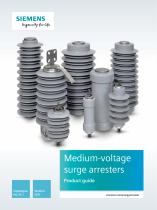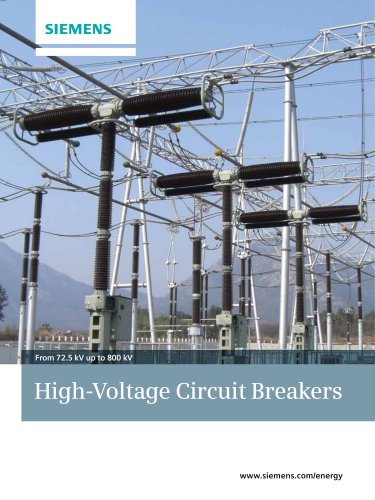
Catalog excerpts

Medium-voltage surge arresters Product guide Catalogue HG 31.1
Open the catalog to page 1
Medium-voltage surge arresters | Product guide Definition of surge arresters Surge arresters are used to protect electrical equipment, such as transformers, circuitbreakers, and bushings, against the effects of overvoltages caused by incoming surges. Such overvoltages can be caused by a direct or nearby lightning strike, an electromagnetic pulse, electrostatic discharge, or switching operations in the power supply system as well as in devices. Some overvoltages are very high in energy. The current from the surge is diverted through the arrester, in most cases to earth. Effective overvoltage...
Open the catalog to page 2
Medium-voltage surge arresters | Product guide Experience is most essential when it comes to reliability in medium- and high-voltage applications. Siemens has been designing and manufacturing medium- and high-voltage surge arresters for standard and special applications since 1925. Continuous research and development, the wealth of Siemens know-how, and comprehensive worldwide experience give Siemens surge arresters a leading edge in overvoltage protection. Their uncompromising quality ensures a long service life and reliability in any application. Siemens surge arresters are an...
Open the catalog to page 4
Portfolio overview Surge arresters for railway applications Siemens surge arresters for railway application protect every part of a railway system from traction substations, transmission lines, cables, and catenary systems to rail vehicles for local, long distance, and high speed services up to 420 km/h. Siemens provides several surge arrester product families for AC and DC rail applications up to 45 kV. For more information, refer to the product guide Surge arresters for railway applications. Medium-voltage surge arresters Siemens provides a wide range of surge arrester product families...
Open the catalog to page 5
Medium-voltage surge arresters | Product guide 1925 Siemens begins developing surge arresters. The first devices are of the so-called cathode drop type. 1847 The ten-employee company Telegraphen-Bauanstalt von Siemens & Halske (Telegraph Construction Company of Siemens & Halske) begins operation on October 12, 1847, in a back building in Berlin. 1971 Development of the first gas-insulated and metal-encapsulated surge arrester for gas-insulated switchgear (GIS). 1989 The 3EQ2 surge arrester for systems of up to 550 kV is one of the first high-voltage surge arresters with composite polymer...
Open the catalog to page 6
History timeline 1998 The polymer-housed medium-voltage/distribution class arresters of the 3EK family, which features Cage Design™, a unique solution with direct silicone molding on the metal oxide resistors, is introduced. 2003 Completion of the first line arrester project, an order from KELAG, one of the leading energy service providers in Austria. 2007 3EL2, the first line arrester for 550 kV applications, is delivered to Sochi, a city in Russia. 2011 Siemens introduces its new range of long rod insulators 3FL. 2014 Siemens launches the 3EL3, the strongest silicone housed cage design...
Open the catalog to page 7
Medium-voltage surge arresters | Product guide The main task of an arrester is to protect equipment from the effects of overvoltages. During normal operation, an arrester should have no negative effect on the power system. Moreover, the arrester must be able to withstand typical surges without incurring any damage. Nonlinear resistors fulfill these requirements thanks to the following properties: ■ Low resistance during surges, so that overvoltages are limited ■ High resistance during normal operation to avoid negative effects on the power system ■ Sufficient energy discharge capability for...
Open the catalog to page 8
MOVs / Standards and testing Standards and testing – reliability you can count on Tests Siemens surge arresters have been designed and tested in compliance with the latest IEC 60099-4, IEEE C62.11, and GB 11032 standards. All type tests are performed by independent, PEHLA- certified laboratories; reports are available on request. Please contact your Siemens representative for details. Moreover, every single surge arrester that leaves the Siemens factory undergoes a routine test and is delivered with a routine test certificate. Quality Assurance Siemens meets all requirements of ISO...
Open the catalog to page 9
Medium-voltage surge arresters | Product guide How to select a suitable surge arrester This section describes the general approach to selecting typical arresters for overvoltage protection in medium-voltage systems. For a detailed description of how to configure a surge arrester, please refer to the handbook “Metal-Oxide Surge Arresters in High-Voltage Power Systems – Fundamentals.”1 The requirements for a surge arrester emerge from two basic requirements: It should provide adequate protection with a sufficient safety margin, which means that overvoltages at the device to be protected must...
Open the catalog to page 10
How to select a suitable surge arrester Step 2: Selection of the nominal discharge current In The nominal discharge current In serves to classify a surge arrester. From a technical point of view, it is calculated from a typical maximum lightning current amplitude that can be expected in the substation, for which the insulation coordination is performed via the arrester’s lightning protection level. This amplitude is calculated from the flashover voltage Ufo of the line insulators, the lightning protection level Upl of the arresters, and the surge impedance Z of the line for Imax: Step 3:...
Open the catalog to page 11
Medium-voltage surge arresters | Product guide Step 4: Selection of the energy class The application guide IEC 60099-5 to the standard IEC 60099-4 describes how the charge transfer and energy handling capability of a surge arrester can be determined. Surge arresters dissipate switching surges by absorbing energy. The charge transfer and amount of energy is related to the switching surge magnitude and wave shape, the system impedance, the arrester protective characteristics, and the number of switching operations. The selected arrester should have charge and energy rating capability greater...
Open the catalog to page 12All Siemens Energy – Power transmission catalogs and technical brochures
-
Tractronic®
10 Pages
-
MVDC PLUS®
1 Pages
-
UPFC PLUS
2 Pages
-
Energy Storage System
4 Pages
-
SVC PLUS®
1 Pages
-
Dead tank compact
1 Pages
-
High-voltage surge arresters
112 Pages
-
SURGE FOR railway applications
16 Pages
-
High-Voltage Compact Switchgear
12 Pages
-
PORTABLE POWER SOLUTIONS
12 Pages
-
High-Voltage Circuit Breakers
15 Pages
Archived catalogs
-
High-voltage cable systems
4 Pages
-
Power generation
20 Pages
-
Steam Turbines
6 Pages
-
Gas Turbines
8 Pages

































